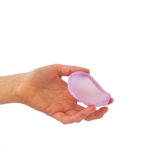What is a diaphragm?
A diaphragm is a soft silicone device with a flexible rim. There is only one type of diaphragm available in Australia. It is one size only and is estimated to fit most people with a cervix. It is a reusable device and should last for two years if properly stored.

How does a diaphragm work?
A diaphragm is placed in the vagina so that it covers the cervix. It acts as a barrier to stop sperm from entering the uterus and fertilising an egg. The diaphragm must be inserted before sexual intercourse and left in place for at least 6 hours after intercourse.
How effective are diaphragms?
The diaphragm is 86% effective with perfect use but with day-to-day use it is 82% effective.
Where can I get a diaphragm?
Diaphragms can be bought from SHINE SA, online and most pharmacies. It is generally recommended that you are examined by a doctor or nurse to check your insertion technique and that the diaphragm fits properly over your cervix. It is a good idea to practise inserting and removing the diaphragm several times before using it for contraception.
What are the benefits of using a diaphragm?
- It contains no hormones.
- It has no effect on your menstrual cycle or fertility.
- It has no effect on breastfeeding or breast milk.
- It can be bought without a prescription
- It can be used with fertility based awareness methods of contraception to improve effectiveness.
- It can be used on an intermittent basis when sexual activity occurs (it can be inserted well before the time of sexual activity if preferred)
- It can be used by people with sensitivity to latex.
What are the disadvantages of using a diaphragm?
- You need to have it with you at any time you have intercourse.
- You need to insert it before intercourse.
- You need to be comfortable about feeling inside your vagina with your fingers to check the diaphragm is in place.
- It is not as effective as some other forms of contraception.
- It doesn’t protect against sexually transmitted infections (STIs).
- It can’t be used by some people with vaginal prolapse.
How to use a diaphragm
- The manufacturer recommends that a teaspoon (about 4 ml) of lactic acid-containing lubricant gel be applied to the upper surface of the diaphragm before use. If the diaphragm is inserted more than 2 hours before intercourse additional gel should be applied.
- Use the dimpled grips and squeeze together the rim. Making sure that the arrow on the device is pointing towards the body, insert the diaphragm into the vagina and gently guide it backwards and upwards towards the small of the back as far as it will go.
- Tuck the diaphragm behind the pubic bone ridge at the front of the vagina.
- Check that the cervix is completely covered by the diaphragm by feeling with your fingers (the cervix usually feels quite firm like the tip of your nose).
- If not in the correct position, remove and try again (to remove the diaphragm, hook the index finger into the dome and pull out).
- The diaphragm needs to be left in place for at least 6 hours after sexual intercourse.
- It should not be left in place for longer than 24 hours without being removed for cleaning.
If additional lubricant is needed before or during intercourse use a water-based lubricant.
The diaphragm should not interfere with passing urine or having a bowel action. The diaphragm should not be felt at any time, including during intercourse.
How to take care of your diaphragm
- Wash the diaphragm in warm water with a mild, unscented soap.
- Rinse thoroughly in clear water and leave it to air dry.
- Store the diaphragm in it’s case in a cool place.
- Check the diaphragm for pinholes or tears by holding it up to the light and gently stretching the dome.
- If the diaphragm feels ‘tacky’ this may mean the silicone is damaged.
When to replace your diaphragm
You will need to replace your diaphragm if it is damaged or no longer fits well. If you have given birth you should check that your diaphragm still fits. Remember, a diaphragm must fit well and be in good condition to prevent pregnancy.
Sometimes accidents happen…
If you did not use your diaphragm, or if it slips out of place, and you are worried about getting pregnant, the Emergency Contraceptive Pill (ECP) is available over-the-counter at pharmacies, SHINE SA clinics, Adelaide Sexual Health Centre and some public hospital Emergency Departments.
ECP is most effective if it is taken within 24 hours of unprotected sex, but can be taken up to 5 days (120 hours) after unprotected intercourse.






